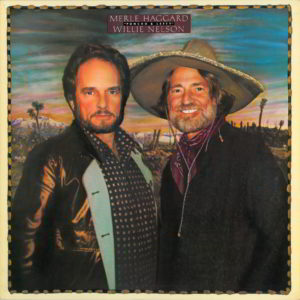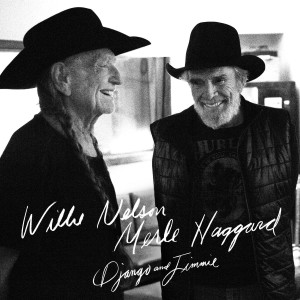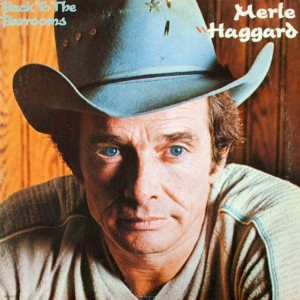
Merle Haggard – The Fightin’ Side of Me Capitol ST-451 (1970)
In the span of less than a year, Merle Haggard released two live albums, Okie from Muskogee (1969) and The Fightin’ Side of Me (1970). Both were named after successful singles released just prior to each respective live album. These songs set the tone for much of the reactionary populist messaging in country music for decades to come, straight though Toby Keith, Brad Paisley, Zac Brown Band and so many others.
Let’s look at the title song from The Fightin’ Side of Me more closely. Haggard later claimed that he did not want to release the studio-recorded single version prior to this album. He wanted to release “Irma Jackson,” a song about interracial romance — not exactly socially progressive in its sentiments but at least tolerant in a libertarian “leave me alone to do what I want” kind of way, without really raising a finger to affirmatively promote racial equality. But his label, Capitol Records (dubbed the house that Nat “King” Cole built), instead wanted to capitalize on the reactionary, populist image Hag had developed with “Okie From Muskogee,” and insisted he release “The Fightin’ Side of Me” as a single instead. “Irma Jackson” was shelved for release, appearing later on 1972’s Let Me Tell You About a Song. It is interesting that Hag went along with all this (would Johnny Cash have done so? His reputation suggests not — more on that later). And after all, Hag still wrote the dang song to begin with.
At first blush, the song seems to be nothing more than a reactionary populist diatribe, decidedly anti-intellectual, belligerently ignorant and just plain angry. It is all those things; but it is also more than that.
Some critics have said it is not a pro-war song as such but rather an anti-anti-war one. This is accurate to a point, but it gives the song a bit of a pass on its more pernicious claims. The lyrics go so far as to say: “I read about some squirrelly guy / Who claims, he just don’t believe in fighting / And I wonder just how long / The rest of us can count on being free.” This sentiment appears directly in the right-wing slogan (sometimes credited to Walter Hitchcock), “Freedom isn’t free.” It is premised on the notion of “freedom” as a purely “negative” concept separate from economic matters: that fighting wars of aggression against impoverished but raw material-rich countries that pose zero military threat to the United States protects domestic “freedom” to do as we will and is therefore necessary, and that possession of material resources should be considered separate and apart from civic rights of action. The people who actually believe this stuff are usually grossly misinformed. That isn’t a knock on those people, exactly, because this misinformation and false consciousness proliferates due to the propaganda model that mass media follows on such matters — most people lack the means to seek out more reliable information, or at least other perspectives, such as ones that ask whether one person’s freedom comes at the expense of the freedom of another. But the idea that “freedom” requires aggressive military action against poorer and weaker official enemies is hypocritical, or at least based on a dubious understanding of context and history.
And yet, the sorts of “freedom” that anti-war protesters were clamoring for in the early 1970s was an irrelevancy for most of the working class, which had no means to authentically act on any of the supposed “freedoms” that college student elites wanted. Rather, one of the only routes many working class students had to a decent education — and associated upward social mobility — in the post-WWII era was via the GI Bill, which funded the education of many veterans and increasingly did so by the Vietnam War era. Therefore, criticism of the military could be seen as shutting off a path to upward social mobility for the working class (at least the white male working class, as minorities benefited less from the program and women hardly at all). In other words, acting on civic freedoms requires material (economic) security too — Jean-Jacques Rousseau long ago argued (as did Erich Fromm, and others, more explicitly and recently) that one without the other was nothing, raising questions about structure and agency and the duty to cultivate civic morality through education that help frame the concept of “positive liberty” today.
Anthropologist David Graeber had this to say about reactionary populism and the military:
“So if you’re a fork-lift operator or even a florist, you know your kid is unlikely to ever become a CEO, but you also know there’s no way in a million years they’ll ever become drama critic for the New Yorker or an international human rights lawyer. The only way they could get paid a decent salary to do something noble, something that’s not just for the money, is to join the army. So saying ‘support the troops’ is a way of saying ‘fuck you’ to the cultural elite who think you’re a bunch of knuckle-dragging cavemen, but who also make sure your kid would never be able to join their club of rich do-gooders even if he or she was twice as smart as any of them.
“So the right wing manipulates the resentment of the bulk of the working class from being able to dedicate their lives to anything purely noble or altruistic. But at the same time — and here’s the real evil genius of right-wing populism — they also manipulate the resentment of that portion of the middle classes trapped in bullshit jobs against the bulk of the working classes, who at least get to do productive work of obvious social benefit.”
In 1970, when Haggard released the song, the draft had recently been instituted United States for the Vietnam War. This was significant, because the prior all volunteer army drew heavily from the working class. It was only when the draft forced middle-class kids into military service — who would never have volunteered — that anti-war protests escalated to a fever pitch. So Haggard’s song would not have made so much sense a few years earlier, because it is as much a statement against urban elites as anything else — this is much the same reason Loretta Lynn‘s anti-war song “Dear Uncle Sam” from 1966 makes sense for a country music star, because it came before the draft when the military had a large proportion of voluntary enlistees from the working class.
Haggard’s song sets aside principles and logic regarding militarism in favor of pure and simple group retrenchment. That is, his song tries to build solidarity among (mostly white, male) working class listeners, ignoring whether they are doing so to fight a good cause or not. Along the way the song is bolstering and solidifying a system that relegates them to a subordinate status, without ever letting on to any recognition that this is happening. It kind of shuts down debate before such matters can even be discussed.
Johnny Cash famously told President Richard Nixon’s staff that he wouldn’t play Haggard’s “Okie From Muskogee” (or Guy Drake‘s “Welfare Cadilac”) at a White House function in April of 1970 — Hag’s “Okie from Muskogee” preaches exactly the same sort of populism as “The Fightin’ Side of Me.” Cash explained in his memoirs that he rejected the request because he didn’t know the song and didn’t have sufficient time to prepare. That is a cop-out answer, really. How did he manage to learn Glen Sherley‘s “Greystone Chapel” on short notice before recording it for his landmark At Folsom Prison album? It is largely because Cash never sang reactionary populist songs like “Okie from Muskogee” (even if he did sing nationalistic, patriotic songs a bunch). In his second autobiography, he wrote:
“The issue wasn’t the songs’ messages, which at the time were lightning rods for antihippie and antiblack sentiment, but the fact that I didn’t know them and couldn’t learn them or rehearse them with the band before we had to leave for Washington. The request had come too late. If it hadn’t, then the issue might have become the messages, but fortunately I didn’t have to deal with that.”
You can almost hear a sigh of relief with that statement, and wonder how honest an account it really is with Cash’s history of playing songs on short notice. While Haggard’s song tended to represent a separatist impulse, meant to distinguish the working class as its own group that kept to itself, Cash always represented instead the more left-wing of the New Deal Coalition that sought to bring different groups together in egalitarian compromise (he was in the left-wing of the New Deal because he avoided and disdained the racism holding the coalition together). Haggard may not have been personally committed to this sort of reactionary political worldview, but by going along with a record company interested in selling records to that audience he had no claim to the moral high ground.
Here is the central contradiction of Haggard’s populism: while the venom for anti-war protesters in “The Fightin’ Side of Me” seems to attack the privileges of wealth, it does so from an uninformed, cynical and self-serving position. Historian Jefferson Cowie — an astute commentator on this period in his book Stayin’ Alive — summed up Haggard’s politics in a word: ambivalence. The morality of ambivalence is not as simple as it may (intend to) seem. It presupposes certain things about the status quo that mask privileges that a white male audience might enjoy over women and racial minorities, for instance, who see nothing compelling about a situation that places them behind white working class males. The working class may have seemed to be enjoying unprecedented advantages in this era, relatively speaking, but it doesn’t require much looking to quickly see that those advantages broke down rather unequally along race and gender lines. Also, by recommending that protest criticisms be shut down, Hag does the dirty work for the powerful by shutting down threats to their continuing supremacy. While no doubt he isn’t directly singing praises of the establishment power structures, and may have his own problems with them, Graeber again notes that this is “extraordinarily convenient” for those power structures. Here we turn to a kind of “collaborationist” model of ethics, that consist in discrete groups taking small benefits from the powerful (~bribes) in exchange for keeping out of efforts by other groups seeking their own gains toward equality. Is there a positive duty to stand up against wrongdoing? The basic position of the audience “The Fightin’ Side of Me” speaks to is “no,” yet for detractors the answer is “yes.” Whether one adopts the philosophy of Rousseau or Kant, which demands positive moral action, or more recent and moderate (even conservative) positions taken by the likes of Hannah Arendt that critique the “banality of evil,” there are many counterarguments. For that matter, Haggard could have voluntarily turned over the profits from these songs to charity, something politicians and business people do from time to time.
Shortly before his overt populist turn, Haggard released the concept/tribute album Same Train, a Different Time: Merle Haggard Sings the Great Songs of Jimmie Rodgers (1969). One reviewer had this to say about it:
“If there is a concept to the record, it is that it is meant to be a music lesson on a personal hero of his who he felt was being neglected by newer audiences. He accomplishes this through between-song narrations (something he would do on many of the albums that followed this one) that establish Rodgers‘ importance as well as his continuity with the counterculture of the late 1960s (as a promiscuous, ramblin’, guitar-pickin’ man).”
While, again, this may be very true, it is worth questioning further. There are a variety of possible motivations behind that album, and at least as many interpretations. But among them should be the possibility of Haggard speaking down to the hippie counterculture to lecture them about how they went wrong. The title of Hag’s Rodgers tribute is “Same Train, A Different Time.” This might be seen as belittling the 1960s counterculture by suggesting they brought forth nothing new — it was the “same train.” Or to the extent it admits any differences (failings or inauthentic echoes), he recalled the music of Rodgers and told tales of his life to present a better and more compelling version, the original. Taken in this light, maybe “Okie” and “The Fightin’ Side of Me” were not so much of a sudden turn, or something forced on Haggard by record execs, but refinements and extrapolations of themes already present in his work. Haggard commented to Record World in an early 1970s interview that he felt the hippies and counterculture were “not really coming up with answers to anything.” But as Noam Chomsky once said in a lecture (on a slightly different topic):
“It’s commonly claimed that critics of ongoing policies do not present solutions. Check the record, and I think you will find that there is an accurate translation for that charge: ‘They present solutions, but I don’t like them.’ “
If anything, the “cultural elites” need to rise above this, and understand the position advocated by Haggard’s song, like Italian filmmaker Pier Paolo Pasolini supposedly siding with the police, the “children of the poor,” against student activists promoting “left-wing fascism” following the March 1968 Battle of Valle Giulia. But support for the police, as with support for the military, has its problems. Everybody involved could stand to take more thoughtful positions on what Hag’s song portrays within its lyrics. As Pasolini said in a final interview, “My nostalgia is for those poor and real people who struggled to defeat the landlord without becoming that landlord.” Haggard’s populism falls short of this mark on “The Fightin’ Side of Me,” by promoting a purportedly peaceful separatism that at best preserves and protects status quo inequalities, and at worst sets up alternate ones hardly any better. It is difficult to find any altruism in the song that isn’t compromised by chauvinism. That is, he will tolerate what some others see as altruism or a social benefit only so far as it does not interfere with chauvinist benefits to him—a perspective based in self-interested bargaining that closes off and renounces the possibility of acting on principal to instead act in a socially conformist way on the condition that a slight personal benefit is obtained.
Yet the album as a whole encompasses a bit more than reactionary populism. Haggard’s wife Bonnie Owens sings Woody Guthrie‘s “Philadelphia Lawyer,” which can be called populist but Guthrie was well known for being left wing rather than reactionary. Perhaps so as not to tarnish Hag’s reactionary “brand” image, though, while still appealing to other listeners, a guest sings that song rather than him. There is also some fairly apolitical material.
The first side of the original LP offers very little to recommend. Some is fine, sure, like the bluegrass tinged “Corrina, Corrina.” But the first side is mostly limping and skirts the edges of what was already on the preceding Okie From Muskogee live album, with a slickness that kind of undermines the songs’ down-home charm. On side two, however, things pick up. There is a funny novelty medley (in a format like The Dixie Hummingbirds‘ “Christian’s Automobile”) in which Haggard does a series of impressions of Marty Robbins, Johnny Cash and Hank Snow. He’s a dead ringer for Robbins and Snow, but he doesn’t quite replicate Cash’s deep baritone voice adequately even though he has down the mannerisms. There also is a fine performance of the B-side “Today I Started Loving You Again,” one of Haggard’s very best romance songs. The performance here is arguably better than the studio version, because it seems more loose and heartfelt. Stepping completely away from the very politically-charged material he’s excellent at probing vulnerabilities in interpersonal relationships.
But he does sing “Okie from Muskogee” too. While it is possible to view at least some of the words to that song as ironic, there is little doubt that the overall effect of the song is reactionary, at least that is how audiences took it and that is what Hag’s label pushed to duplicate after its success was attributed to a reactionary reading. The album cover, for that matter (who knows if Haggard had any say in its design), has a blue background with white stars and red front, in a kind of patriotic homage to the U.S. flag. Together with all the rest of the album’s contents, the nationalistic graphics and design of the packaging reinforce the underlying provincial attitudes in an unfortunate way. In Hag’s case his politics might be summed up as resurgent settler-colonialist “Jacksonian democracy” right populism of the “patriotic” sort.
Haggard remains one of the biggest names in popular country music. There are intriguing concepts in his work that are not as one-sided as they are sometimes portrayed. And yet there is little to commend in the bitterly antagonistic, self-serving qualities that seemed to make this album popular at the time. There may be layers to this, but the ones that lean on reactionary populism very nearly overwhelm everything else. As music meant to take a lot of pride in what it is, there is nothing courageous about this, and its integrity waffles too readily. In many ways, the flaws in the sentiments expressed here sowed the seeds for the downfall of the working class in the United States in the 1970s, as compassion and solidarity waned and a brand of breakaway individualism came to be a dominant narrative.




